Needham Broughton High School, Raleigh, N.C.
With the school year winding down to a close, Flashback Friday drops in this week on Raleigh’s oldest high school still in use — Needham B. Broughton. The monumental building has stood prominently at the corner of Peace and Saint Mary’s Streets since 1929.
Constructed in 1930. One of Raleigh’s two new and modern high schools. The enrollment at each is over one thousand.
The card was postmarked June 28, just in time to be received by ‘Margo’ before the July 4th holiday.
Dear Margo
Can’t you come up Sat & stay thru Wed or Thurs? I just found out I get off on the 4th. Call me if you can at 32045. If you can’t, don’t call.
Martha
(Can’t you come  by yourself just once on the bus. Maybe Fran can come to see [illegible].)
I wonder if Margo ever did take that bus to Raleigh all by herself?
A Young Architect’s First Major Commission
During the 1920s Raleigh’s center of population was shifting away from downtown to the new middle class suburbs sprouting up in the northwest precincts of the city.
Although a magnificent new high school (Hugh Morson High School) had been erected near Moore Square in 1924, within just a few years the school system found itself grappling with the steep rise in high school aged students and the migration away from the city center. Thus, the board opened a design competition for a new high school to be built in the northwest part of town.
William Henley Deitrick opened his architectural practice in 1927, the same year he entered the design competition. Deitrick had worked for the school board since 1925 as supervisor of construction of the half dozen or so school buildings built in Raleigh in the mid-1920s.
The young architect’s bold proposal was unlike any other seen heretofore in North Carolina school design. Although a dozen well-seasoned architects vied for the commission, Deitrick was awarded the contract — despite the fact that “some architects complained about the selection of a young ‘newcomer’…” (Elizabeth Waugh, “Firm In an Ivied Tower”)
The high school design received an award from the American Institute of Architects in 1930 and catapulted Deitrick’s career as a successful and respected architect.
Deitrick embraced the modernist aesthetic in the mid-1930s, and his firm became known for many of Raleigh’s finest modernist buildings, including the Nehi Building (1937), the Rex Hospital Nurses Home (1938), Carolina Country Club (1948, demolished), NC State Student Union (1950), and Dorton Arena (1951).
Broughton High School and …
The design of Raleigh’s new high school has been characterized as “Italian Lombard Gothic with Romanesque motifs.” The original building (many additions have been made over the years) is 414 feet long and 236 feet deep. It is built of steel and reinforced concrete, and is faced with Wake County granite.
The broad, symmetrical facade is punctuated by a 95-foot clock tower, which is flanked by an H-shaped classroom core, with auditorium and gymnasium wings extending beyond. It sits at the center of a 10-acre site. Architectural details include an orange clay tile roof, cast stone embellishments and massive wrought iron entry gates.
This 1950s photo shows the massive granite walls and many of the building’s architectural details.
Known as Raleigh’s “New High School” for several years, it was later named in honor of Needham Bryant Broughton (1848-1914), a Baptist church leader, Raleigh businessman, member of the Raleigh School Board, and supporter of public schools.
This linen-finish postcard from the 1930s depicts Raleigh’s two (white) high schools as they appeared at the time. Hugh Morson was built downtown in 1924 and is characteristic of the design of public schools built in Raleigh from the 1910s into the 1920s. Broughton High School clearly shows the design break with the earlier mode.
… Its Legacy
For many decades Broughton has enjoyed a reputation as Raleigh’s premier public education facility. Many of its alumni have been recognized later in life as among the city’s prominent businessmen, politicians, developers and social leaders.
Even so, Broughton High School experienced a bit of national exposure during the early years of the civil rights movement when Martin Luther King, Jr. delivered his “Non-Violence and Racial Justice” speech there on February 10, 1958. King had been invited to Raleigh by the United Church, then located on Hillsborough St. The building was too small to accommodate the expected crowd, so arrangements were made to use the auditorium at Broughton.
Martin Luther King, Jr. delivered his “Non-Violence and Racial Justice” speech to a packed crowd in Broughton’s auditorium on February 10, 1958.
Long a significant player in Raleigh’s history, Broughton High School has been designated a Raleigh Historic Landmark.
Of particular interest this week is that the talented and prolific North Carolina photographer Bayard Wootten took the photo of Broughton High School reproduced here on our featured postcard.
Wootten was a major regional photographer and perhaps North Carolina’s most significant photographer during the first half of the twentieth century. Her photographic collection is housed in the North Carolina Collection Photographic Archives, University of North Carolina Library at Chapel Hill.
Our Flashback Friday ‘white border’ halftone postcard this week was published locally by long-time Raleigh stationer and office outfitter Alfred Williams & Co. It was printed by Gray and Thompson Advertising of Chapel Hill.
“Flashback Friday†is a weekly feature of Goodnight, Raleigh! in which we showcase vintage postcards depicting our historic capital city. We hope you enjoy this week end treat!

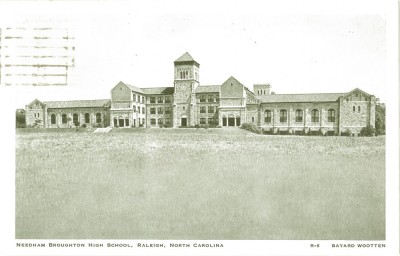
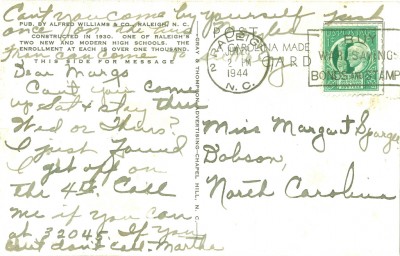
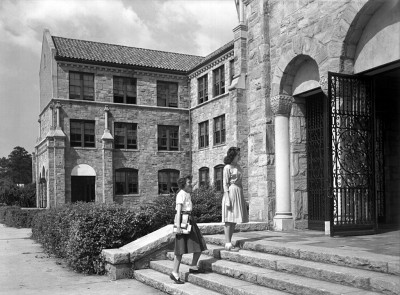
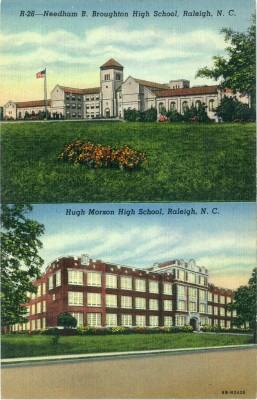
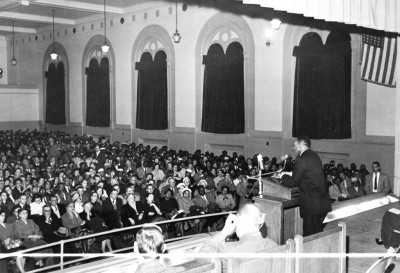
 Sign up for the Newsletter
Sign up for the Newsletter
05/30/2014
Broughton was constructed in 1929, not 1930. The massive walls are not granite, they are leucogneiss which was quarried where Glenwood Village Shopping Center is now. (Is it still called that?) Behind the Harris Teeter, you can see the stone outcropping from the old quarry walls.
05/30/2014
Thanks for the article – I really enjoyed it. Bill S. I had not noticed the stone outcropping behind the Harris Teeter (in the old Sears building right?) But I will check that out the next time I take a run back home.
05/30/2014
No. Behind the Harris Teeter in Glenwood Village Shopping Center. That is the small strip mall where Oberlin Rd and Glenwood Ave intersect. If by “the old Sears Building” you are referring to the Sears Building on Six Forks Rd near where it intersects with Old Wake Forest Rd, there are some good metamorphic outcrops there. It used to be a Field Stop for Introduction to Geology labs from NCSU. But the last time I tried to get back there, it was too overgrown to be accessible.
05/30/2014
OOPS!! Maria: I just realized that you are thinking of the Harris Teeter in Cameron Village, which is where the old Sears was before it moved to the then-new Crabtree Valley Mall. As I said, I was referring to the Harris Teeter in Glenwood Village Shopping Center.
05/30/2014
And using this overlay map you can see that Oberlin Road and St Marys Street both were once the Old Hillsborough Road (Also the Upper Hillsborough Road according to Elizabeth Reid Murray)connected by McDonald. Nice easy haul from pit to construction site. http://www2.lib.unc.edu/dc/ncmaps/interactive/Cm912c_R163_1935r.html
05/30/2014
Feels like home to me….
05/30/2014
I attended Enloe High School. One summer I had nothing to do (is that sad or what?) so I voluntarily attended summer school for one class. It was held at Broughton. I thought that the old building was really creepy. But, then again, I thought that Morson was way creepy. I think that now I would better appreciate both of the buildings.
05/31/2014
What a great school. I graduated in ’60. I recall my parents moving to Cary, and having me transfer from Broughton to the high school there. I lasted about three weeks. Demanded to return to Broughton, which I did. If high schools can be called Ivy League, Broughton certainly has the title.
06/01/2014
Bill S — Thank you for your comment. My source for the architectural description of Broughton HS was the Raleigh Historic Development Commission’s report on the property for its designation as a Raleigh Historic Landmark. http://rhdc.org/sites/default/files/Needham%20Broughton%20HS%20Landmark%20Report_sm.pdf To wit: “tan local granite;” or, more technically, “Falls leucogneiss,” http://www.ncgeology.com/falls_lake_geology/pages/falls%20leucogneiss%20and%20dam.html commonly referred to as “leucogranite.”
As far as the date of completion being 1929, the article states that fact right there in the second sentence. The 1930 reference is from the postcard publisher’s description on the back of the card (in block quotes). Errors in details such as this crop up all the time on vintage postcards. Of course we all know the actual date of construction was 1929.
06/03/2014
I graduated NBHS in 1965. It was a wonderful place to go even though it was the only HS available for me. I loved going there although walking up & down the steps to class was hard sometimes. I also was able to enjoy lots of historical changes as the first African Americans to attend NBHS.
06/09/2014
I graduated from Broughton in 1954 and have been attending the high school reunions every five year, coming from Santa Clarita, CA. I will be attending again this August and hope to see lots of my classmates.
06/16/2014
What a fun article for one who grew up in Raleigh, graduated from NBHS in 1958, and loved all 5 years at Broughton! Surely Broughton was—and still is—one of the premier high schools in the state. Indeed, how many high schools can boast an active slumni association, one whose members so valued their own high school education that they donate to scholarships for current students? I loved and appreciated the building, too, and am grateful that it retains at least some of the original architectural uniqueness. Thanks for a trip down memory lane.
08/15/2015
I graduated from Broughton in 1975. Of course, in my youth the building felt like it was very old, which relatively it was, about 3 times my age. I got there during the second year of forced busing and I remember great conflict with police often in the hallways of the school and some gang type fighting that got very ugly. A distinct clash of cultures that had to be a reality as desegregation was a necessary part of integrating our American culture. The isolated stairwells were particularly interesting from a social standpoint as often students would stop and loiter. The strict policy of being where you were supposed to be and the rigid timeline of getting there made Broughton feel very authoritarian. Without a hall pass if you out of place you were banished from the school for a couple of days. I remember the section of the Broughton behind the main building and and behind Holiday Gym became the authorized smoking section where all contraband seemed in play. There was an element of danger that I kind of enjoyed. I had a study streak rebellion that I tried to keep hidden during my days in high school….. All in all though I have good memories at Boughton and thought it prepared me well for college. I have always thought the building was pretty and magnificent….
05/16/2017
Carl – Yes there was a lot of tension. I graduated in 1973. My first summer job afterward was to install one-way mirrors in all the bathrooms, so students had to be aware that they were possibly being observed by a teacher. It was a bit of a lark to take a jack hammer to my alma mater, but those hallowed walls were at least a foot thick!
Pink hall passes were critical for skipping classes. We snagged a couple of pads of blank ones, and one student was a master at forging the attendance counselor’s signature. Whenever I got called to her office, I had to commit to memory — Monday 5th period pass is in this pocket, Tuesday 3rd period is in that pocket… She never realized that the signature she was looking at was not her own.